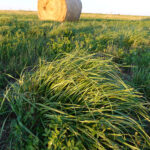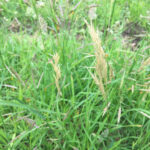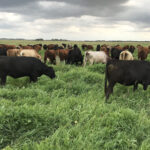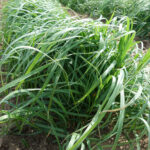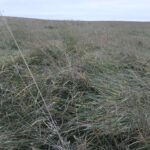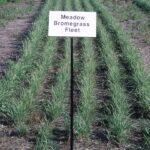Meadow Bromegrass
Bromus riparius
General Description
Meadow bromegrass is a hardy, long-lived, high-yielding, cool season perennial grass. It regrows very quickly after grazing, even late in the season. Meadow bromegrass has fibrous roots and short rhizomes that spread slowly.
Meadow bromegrass stems grow up to 1.2 m (47 in) tall with many basal leaves in established stands. Both the leaves and sheaths have long, sparse hairs. Growing points remain near the ground throughout the growing season. Seedheads are 20 cm (8 in) long with purple-tinged spikelets. Seeds are very long and awned, which can cause bridging when seeding. Meadow bromegrass can spread slowly both by seed and short rhizomes.
Type
Tame grass.
Origin
Turkey. Varieties developed in Canada.
Longevity
At least 20 years.
Use
Pasture, hay, stockpiled. Meadow bromegrass is well suited to rotational grazing or can be managed in a continual grazing system.
Optimal Time of Use
All seasons. Meadow bromegrass should be allowed to reach 20 to 30 cm (8 to 12 in) – a minimum of 4 leaf before turn-out. Early grazed or cut meadow bromegrass can be stockpiled for fall, win¬ter, or spring grazing. Time grazing to allow root reserves to build prior to fall. For hay, cut meadow bromegrass at early bloom stage for the best yield and quality. Although older stands may produce less seed heads, cut at the same stage/time.
Recovery After Use
Recovery can occur within 30-45 days. Meadow bromegrass growing points are near the ground level, thus it can be grazed repeatedly over the season, since defoliation from grazing is usually well above the growing points. Leaving sufficient leaf material (10 cm or 4 in) will result in superior regrowth yields. Hayed meadow bromegrass can be grazed after sufficient regrowth, or stockpiled for later use.
Palatability/Nutritional Value
Meadow bromegrass is a very palatable grass with a slight decline in palatability as it matures. Before flowering and head development, crude protein can be 15 to 20% and with a high Total Digestible Nutrients. It can tolerate early frosts and maintains its quality well during the fall, winter, and following spring making it ideal for stockpilied and dormant grazing.
Annual Precipitation min/max (mm)
350mm / 600 mm.
Drought Tolerance
Good tolerance. Meadow bromegrass can recover quickly from drought, with brown leaves becoming green as soon as moisture is available. Drought tolerance may not be dependable in areas of low precipitation, however, advances in varieties have allowed for good adaptation within the brown soil zone.
Flooding Tolerance
Withstand up to 2 weeks of spring flooding. Meadow bromegrass has poor tolerance to excess soil moisture, but thrives in moist soils.
Winter Hardiness
Good hardiness. Meadow bromegrass hardiness is enhanced with snow cover and some plant carryover left to insulate plants.
Soil Texture Preference
Meadow bromegrass grows well on moist but well drained sandy, loamy and clay soils.
Erosion Control
Moderate erosion control. Meadow bromegrass has fibrous roots and short rhizomes to hold soil.
Salinity Tolerance
Slight tolerance. Meadow bromegrass is less saline tolerant than smooth bromegrass.
Acidity Tolerance
Moderate tolerance.
Alkalinity Tolerance
Moderate tolerance.
Seeds per kg
191,000 seeds/kg (87,000 seeds/lb)
Suggested Mixtures
Base mix on use and the environment. Meadow bromegrass is compatible with any legume for grazing or haying and nearly any grass. Cicer milkvetch and meadow bromegrass stand out as a good stockpiled mix. Meadow bromegrass may be included in mixes with other grasses such as slender wheatgrass, northern wheatgrass, timothy, tall fescue, orchard grass, or western wheatgrass.
Ease of Establishment
Meadow bromegrass establishes easily with vigorous seedlings under care. Meadow bromegrass should be seeded 1.5 – 2 cm (1/2 to 3/4 in) deep with good soil contact. Decreasing weed competition and ensuring proper seeding rates due to large seed size fosters good establishment.
Competitiveness
Meadow bromegrass can compete well with weeds once established. It has a very slow rate of spread.
Management Considerations
Seed meadow bromegrass with a legume to increase forage yield and quality. Meadow bromegrass responds well to fertilization. Stockpiled meadow bromegrass can retain quality into the following spring. Variety development has allowed for successful use in the brown soil zone when field characteristics are compatible – choose a suitable variety.
British Columbia Rangeland Seeding Manual, Saskatchewan Dryland Forage Species Adaptation Tool, USDA Plants Database, Manitoba Forage Adaptation and Comparison Guide, Alberta Forage Manual
Meadow bromegrass is adapted to the Sub-Boreal Spruce, Sub-Boreal Pine-Spruce and Interior Cedar-Hemlock zones. In the southern part of the Central Interior region, meadow bromegrass is adapted to dryland applications in the Interior Douglas-fir zone and is suitable with irrigation in drier parts of the Bunchgrass zone.
Meadow bromegrass has dryland adaptability in the Ponderosa Pine, Interior Douglas-fir and Interior Cedar-Hemlock zones and is suitable with irrigation in drier parts of the Bunchgrass zone.
Meadow bromegrass is widely adapted to the Peace-Liard regions, but choice of variety is important. In variety trials, Fleet had higher yield than Regar at Groundbirch, while Paddock had higher yield than Regar near Ft. St. John. Fleet and Paddock varieties of Meadow bromegrass were developed at Saskatoon, Saskatchewan. Regar was developed in Idaho.
